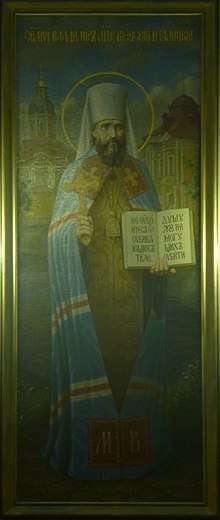Vladimir Bogoyavlensky
Vladimir (Russian: Владимир), baptismal name: Vasily Nikiforovich Bogoyavlensky (Russian: Василий Никифорович Богоявленский; 1 January 1848 – 7 February [O.S. January 25] 1918), was a bishop of the Russian Orthodox Church. He was appointed the position of Metropolitan of Moscow and Kolomna between 1898–1912, Metropolitan of St. Petersburg and Ladoga between 1912–1915, and Metropolitan of Kiev and Gallich between 1915–1918. Murdered by Bolshevik soldiers in 1918,[1][2] Metropolitan Vladimir was glorified as a Hieromartyr by the Russian Orthodox Church in 1998.[3]
.jpg)

Priesthood
Born to a family of a clergyman in Tambov Governorate, Vasili Bogoyavlensky graduated from a seminary in Tambov and Kiev Theological Academy. He then returned to Tambov to teach at his alma mater. In 1882, Vasili was ordained a priest in a town of Kozlov in Tambov Guberniya.[4] On the death of his wife and child in 1886, he was tonsured (took monastic vows) being given the religious name of Vladimir, and was appointed igumen (abbot) of the Trinity Monastery in that same town.
Bishop of Samara and Stavropolsk
In 1888, Igumen Vladimir was sent to St Petersburg as a vicar to assist the Metropolitan and was thereafter consecrated as a bishop. He was soon assigned to preach in Samara. When the country was afflicted by the epidemic of cholera and crop failure, he called upon the clergy and laity to help the needy and often conducted moliebens himself, beseeching the Lord to deliver people from calamities.[4]
For six years, from 1892, Vladimir administered the Georgian Exarchate, paying special attention to the spiritual enlightenment of the multiethnic Orthodox population of the Caucasus, and opening new churches and parish schools.[4]
Metropolitan of Moscow and Kolomna
In 1898, Bishop Vladimir was summoned to Moscow where he was appointed Metropolitan of Moscow. During the events of October 1905, Metropolitan Vladimir wrote an address entitled, "What should we do during these troubled days?" (Что нам делать в эти тревожные наши дни?) and ordered that it be read aloud to the people in all of the churches in and around Moscow. In this address, he told the people of Moscow about the "criminal" and "anti-Christian" intentions of those who had compiled The Protocols of the Elders of Zion. Metropolitan Vladimir's address made a huge impression on those who confessed Russian Orthodoxy. He himself read his speech in the Assumption Cathedral of the Moscow Kremlin. Assessing the Protocols, Vladimir directly associated its authors' "monstrous" intentions with the revolutionary events in Russia, examining the then-ongoing social disturbance in the Russian society from a religious, not political, point of view. He urged the Orthodox people to stand up against the Anti-Christ.
Metropolitan of St. Petersburg and Ladoga
Upon the death of the Metropolitan Anthony of Saint Petersburg in 1912, Metropolitan Vladimir was chosen to fill this post. His successful career in this city, however, came to an end because he had been criticizing Grigori Rasputin's influence on the Church.[5]
Metropolitan of Kiev and Galich
In December 1915, Vladimir was sent away to Kiev. Was Metropolitan of Kiev and Gallich from 1915 to 1918. A few months after the October Revolution, Metropolitan Vladimir was arrested by five Red Army soldiers on 7 February [O.S. January 25] 1918 when the army of Muravyov swept through Ukraine and in front of his monks was immediately executed and his body mutilated.[6]
Metropolitan Vladimir was glorified (canonized) as a saint by the Russian Orthodox Church on October 4, 1998. His feast day is celebrated on January 25, the date of his martyrdom. The Russian Orthodox Church follows the traditional Julian Calendar in determining feast day; currently, January 25 falls on February 7 of the modern Gregorian Calendar. He was the first bishop to suffer as a New Martyr under the Soviets.[7]
See also
- List of unsolved murders
References
- "Saint Vladimir, Metropolitan of Kiev and Gallich". www.oca.org. Retrieved 2019-11-10.
- "Martyrdom - the Crown of the Humble. Hieromartyr Vladimir of Kiev". www.pravmir.com. Retrieved 2019-11-10.
- "St. Vladimir, Metropolitan of Kiev and Gallich. Commemorated on January 25". OrthoChristian.Com. Retrieved 2019-11-10.
- "Metropolitan Vladimir (Bogoyavlensky) of Kiev", Holy Trinity Cathedral
- Smith, Douglas (2016-11-22). Rasputin: Faith, Power, and the Twilight of the Romanovs. Farrar, Straus and Giroux. ISBN 9780374711238.
- "Vladimir, Metropolitan And Hieromartyr Of Kiev". www.orthodox.net. Retrieved 2019-11-10.
- "Vladimir (Bogoyavlensky), metropolitan of Kiev and Galicia, new hieromartyr, first hierarch-martyr of the communist yoke in Russia (Far Caves) | RUSSIAN ORTHODOX CATHEDRAL OF ST.JOHN THE BAPTIST". stjohndc.org. Retrieved 2019-11-10.
External links
- St Vladimir, Metropolitan of Kiev and Gallich Orthodox icon and synaxarion
- ВЛАДИМИР (Богоявленский), священномученик, митрополит Киевский и Галицкий
| Preceded by Flavian (Gorodetsky) |
Metropolitan of Kiev and Gallich 1915–1918 |
Succeeded by Anthony (Khrapovitsky) |